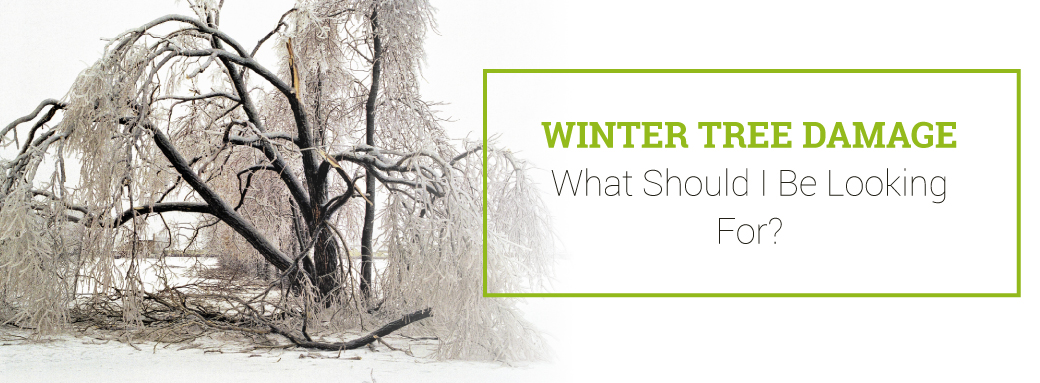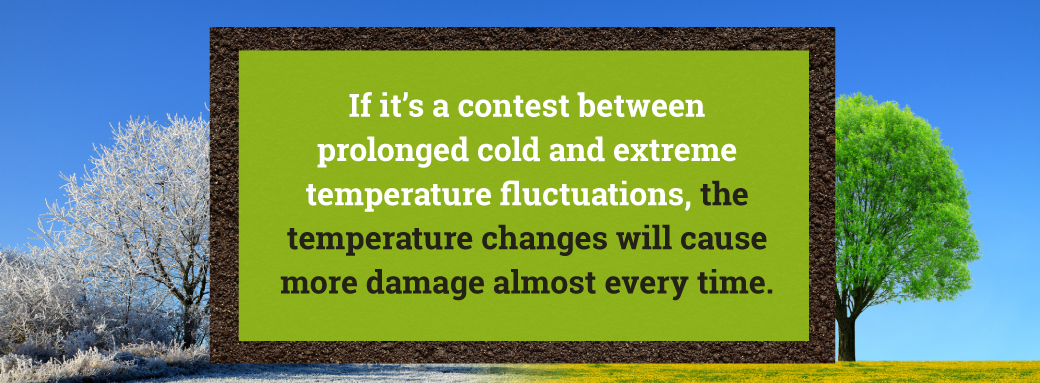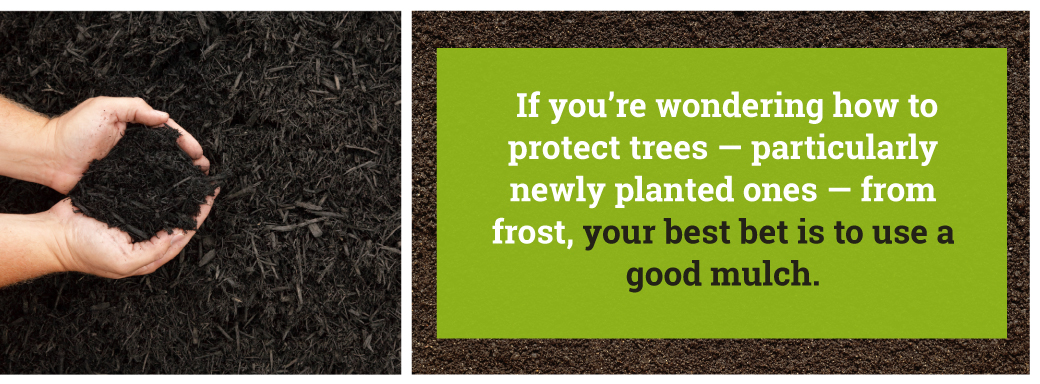
Winter Tree Damage - What To Look For & How To Prevent It

Preparing for winter is no small task. There's a lot to think about. You might need to fit your car with snow tires. You might need to buy wood for a fireplace. And you might have flowers or shrubs that need to be properly winterized to help them survive the coming snows.
But what about your trees? Do you need to do anything to them to help them outlast the snow, ice and cold? And if so, what? Perhaps more importantly, how do you begin to recognize if the winter is damaging your tree? Are there telltale signs to keep an eye out for? Can a tree actually freeze to death?
With winter on the horizon, we understand these are pressing questions on your mind as you prepare yourself, your house and your yard to face the cold.
That's why we've put together this comprehensive guide to winter tree damage — how to understand it, how to prevent it, how to notice it, and how to deal with it after it's already happened. Here are a few seasonal changes to watch out for that could affect your trees.
1. Temperature Fluctuations
It's no secret that plants don't usually respond well to cold temperatures. Most plants go dormant for the winter, shedding all leaves, greenery and blossoms. Some even disappear entirely underground, hiding beneath the dirt until spring. However, trees don't have this option. Although they lose their leaves, they remain entirely exposed to any cold and ice that might come during the winter.
Despite this, it isn't necessarily the extremely cold weather that harms a tree the most during the winter. Instead, it's the intense temperature fluctuations that often cause the greatest amounts of damage.
When the weather changes gradually, trees have time to slowly acclimate to the new temperatures, even if they are very low. But when the extreme cold comes on very fast, this can cause a great deal of harm to trees that aren't yet fully dormant and haven't had time to adjust to the cold.
Similarly, if the weather becomes slowly warm again in the middle of winter only to become suddenly very cold again, the tree is likely to suffer damage. In this way, a mostly mild winter with one particularly vicious cold snap can be more devastating for trees than a long winter of consistent cold.
2. Low Temperatures
The way a tree responds to low temperatures depends very much on the species of tree, as well as the climate zone. If a tree is native and hardy to a particular climate zone, it's unlikely to experience damage from the cold. After all, it is used to these temperatures and naturally equipped to withstand them.
However, if a tree is not native to a climate zone, problems may begin to arise. If a tree is only marginally hardy, it may be damaged by lengthy periods of extreme cold. If you have your heart set on planting a barely-hardy tree for your area, try planting it in a slightly shaded area, where it will be protected by your house, a barn or other trees.

Even when considering how the extreme cold can damage non-native trees, temperature fluctuations still are statistically more damaging. If it's a contest between prolonged cold and extreme temperature fluctuations, the temperature changes will cause more damage almost every time. Unless the tree is very young, simple cold temperatures are very unlikely to cause a tree to freeze to death.
3. Snow and Ice
When we talk about how much damage snow can cause, it's important to clarify what kind of snow you mean. A light flurry or snowfall will cause no harm to trees, unless they're native to much warmer climates and have no business being in a snowy climate at all. But for most deciduous and evergreen trees, snow is perfectly safe and will cause no damage.
The only time snow can cause a real problem for your trees is when there is an excessive amount. Substantial amounts of heavy, wet snow can cause branches to snap and break, creating health problems and aesthetic damage. If you notice a buildup of heavy snow in your tree branches, do your best to gently knock the snow down. If it's frozen in place, don't attempt to remove it, as this may do more harm than good.
Ice, on the other hand, can pose a real damage to many trees. Most regular icing will be fine, as trees native to your area should be prepared to face the conditions. However, harsh ice storms can cause cracks and damage to trees. If you notice ice forming on a tree, it's important not to try to force the ice off. Instead, let it melt naturally to avoid causing more harm.
4. Frost
Since frost is a natural part of winter, it usually doesn't pose a threat to trees. The exception to that rule is when a frost comes unexpectedly, before a tree is fully dormant and acclimated to the cold. In some cases, these frosts can cause frost cracks.
Sometimes known as radial shakes, these look like long, vertical cracks or splits in the tree trunks. They're most likely to occur when the temperatures drop below 15 degrees Fahrenheit, and are more common on the south side of trees that experience greater temperature fluctuations.
The trees that are most susceptible to these types of cracks are oak, red Maple, London plane, Norway, walnut, crabapple, linden, horse chestnut and willow. Furthermore, once a crack has appeared, it has a far greater chance of returning every year.
5. A Spring Freeze
Depending on when a spring freeze arrives, it can be very hazardous to your trees. The reasons for this are twofold.
It's a similar idea to that of the temperature fluctuations. Because it's spring and the weather has most likely begun to grow warmer, the trees have begun to re-acclimate to the spring temperatures. A sudden freeze that arrives unexpectedly could cause a great deal of damage because the tree will not be prepared to handle it.

Secondly, a spring freeze can cause harm to any new growth or buds that have already started to appear. This damage will likely not be severe, as the buds will return. At worst, the tree will experience less growth during this particular year. The injuries won't be lasting, unless the tree is very young or fragile.
Do Animals Cause More Tree Damage in the Summer or the Winter?
In addition to worrying about tree damage from the natural elements, it's important to consider potential danger from small animals. During the winter, food becomes scarce — so scarce that small animals like mice and rabbits may feed on the bark of a tree to survive. This usually isn't a problem in the summer, as food is typically plentiful.
Because of this difference in food supply, animals are more likely to cause damage to a tree during the winter. In the summer, your biggest pest concern is likely to be bugs and other insects.
Signs of Winter Damage
The following are several of the most common signs of winter damage on your trees, as well as how to deal with them after it's already happened:
- Broken Branches: Unless they're creating an imminent hazard, leave broken branches until spring. Then, take the opportunity to remove them and prune the tree. The pruning will stimulate new growth, and the tree will return to its old self in no time.
- Frost Damage: You'll notice frost damage on trees when your foliage turns a dark shade of brown or black. Wait for the damaged foliage to drop by itself. New growth will eventually grow to replace it. If the leaves don't fall, prune them yourself after the cold weather passes.
- Rodent Damage: This is easy to notice. You'll see the bark has been stripped away where small animals have been chewing on it. Unfortunately, once this damage has happened, there isn't much that can be done to repair it — except to wait and prevent it from happening next year by wrapping your tree.

How to Prevent Damage to Your Tree During the Winter
Now that we've covered some of the basic concerns to worry about during the winter, let's talk about how to prevent those common culprits from damaging your trees this winter.
1. Choose Hardy Plants
At the end of the day, your winter success will be determined in large part by the species of your trees. If you plant trees that aren't prepared for your climate, the odds are good that they'll be damaged during the winter. Even the best care can't prevent this. If a tree isn't intended to live in a certain climate, there's very little you can do to change it.
However, if you wish to try a tree that is marginally or barely hardy in your climate, there is a chance it could thrive. For the best results, take extra care to winterize this tree. Protect it from the worst of the elements by placing it in on the side of a building, or perhaps someplace where a grove of more hardy trees will shield it.
2. Don't Prune or Fertilize Late in the Summer
Pruning and fertilizing have something in common — they both stimulate a plant to produce new growth, new greenery and new buds. This is great in the spring and summer. After all, that's when a plant is supposed to be blooming and looking beautiful.
Unfortunately, that's not the case in the late summer and fall. In the fall, trees and plants are supposed to lose their blooms and foliage and go dormant in preparation for a cold winter. By pruning them in the fall, you “trick” them into thinking it's time to grow again. This means they begin putting out new growth instead of getting ready for winter. As a result, they're unprepared for the first frosts and are more likely to experience damage from these early blasts of cold.
3. Use Mulch to Protect the Roots
Sometimes, the deepest or most sudden cold spells can reach and damage roots. If the tree is particularly young or has shallow roots, it's at an even greater risk. If you're wondering how to protect trees — particularly newly planted ones — from frost, your best bet is to use a good mulch.

To protect the roots from ice and frost, lay down leaf litter, snow cover or mulch. These layers act as insulation, helping the earth to maintain more of its natural heat and preventing it from growing too cold too quickly.
4. Wrap the Branches
We already mentioned how heavy loads of snow can weaken or break branches, especially younger and smaller branches. To prevent this from occurring, tie the tree branches together. Do this loosely and gently, using twine or strips of cloth, then remove it in the spring.
If you tie the tree branches together properly, there will be no natural surfaces for the snow to collect on in a damaging way.
5. Wrap the Tree Trunk
The best way to keep your tree trunk safe from the little animals that want to nibble on it is to make sure they can't get to it. By wrapping the trunk in heavy duty cloth or screen wire, you're preventing animals from accessing the bark. This technique of wrapping your tree for the winter is known as girdling.
Another technique that's more effective against mice, which tend to eat away at the tree at the very base and not above the snow line, is to clear the area. Make a small radius around the base of the tree that's completely free of grass or weeds of any kind. This will deter these small pests from thinking they'll find food there.
6. Water Young Trees Until the Ground Freezes
The trees most likely to survive a long and cold winter unscathed are healthy ones. That means it's important to keep your young, more vulnerable trees healthy in the weeks leading up to the first frost. If it's been dry, give them plenty of water to keep them healthy, strong and ready to last out the cold winter months.
Request Your Consultation From Richard's Tree Service Today
Do you have more questions about how to get your trees ready for the upcoming winter? Are you curious about the specific tree species you have and their odds of surviving the winter? At Richard's Tree Service, we can answer these questions and many more. We provide services from pruning and evaluation to tree removal and stump grinding. We're also a family owned business that's been providing quality service for more than 20 years. We even offer free estimates at your house.
If you have tree-related work that needs to be done, contact us today to request your consultation.
If it is an emergency please call us immediately at 703-354-3667.
Use this form to schedule a FREE estimate. After submitting your form, our team will contact you to set up this appointment.
